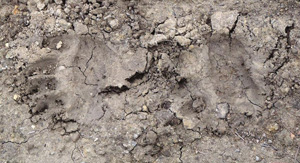Report a Large Mammal Sighting in Indiana
The Indiana Division of Fish & Wildlife occasionally receives reports of large carnivores such as mountain lions, gray wolves and black bears.
There are currently NO breeding populations of these species in Indiana. But one of these animals may pass through Indiana from established populations in other states.
You can report a sighting of these animals online.
Though not a large mammal, bobcats may also be reported online.
Black Bear Facts
Description
- They are stocky animal with short legs.
- Typically, males weigh 150-400 pounds and females weigh 100-250 pounds.
- In the Eastern United States, black bears typically have a thick black coat with a tan muzzle.
- They are omnivorous, feeding on grass, seeds, berries, insects, rodents and deer carcasses.
- Black bears are intelligent with a keen sense of smell and hearing.
- Young bears, particularly males, may travel long distances, up to 20 miles per day, into new areas, before retreating to establish a territory closer to the primary range.
- Black bears are generally very timid and not aggressive towards people.
- They are crepuscular, meaning they are usually active at dawn and dusk.
Living with bears
Residents in many states co-exist peacefully with black bears. They do this by not harassing bears and keeping attractants (food sources) away from them. Once a bear associates humans with a reliable food source, they will almost always seek those again, regardless of where they are released.
Bears can smell food from more than a mile away, so it’s important to secure food sources and discourage animals from associating humans and human dwellings with food. To reduce or eliminate bear-human conflicts please observe the following tips:
- DO remove bird feeders and bird food from late March through November.
- DO clean and store grills away after use.
- DO eliminate food attractants by placing garbage cans inside a garage or shed.
- DO pick ripe fruits and vegetable ASAP, or place an electric fence around them, to ensure bear cannot reach them.
- DON'T intentionally feed bears. Bears that become accustomed to finding food near your home may become “problem” bears.
- DON'T leave pet food outside overnight.
- DON'T add meat or sweets to a compost pile.
- DON'T climb a tree, but wait in a vehicle or building for the bear to leave the area.
REMEMBER: Black bears are rarely aggressive toward humans. Most problems arise when bears associate food with humans. Do not feed bears; doing so increases the likelihood of negative bear-human interactions. Unfortunately, a fed bear often becomes a dead bear due to increased aggressiveness associated with the loss of fear of humans. Thank you for your help keeping our wildlife wild.
Laws regarding black bears
Black bears were once an exotic species, and are now protected under Indiana Administrative Code 312 IAC 9-3-18.8.
News releases
- Nov. 11, 2018 - Black bear hit by motor vehicle near New Albany
- July 18, 2016 - DNR confirms black bear report in southern Indiana.
- July 17, 2015 - Black bear to be trapped and relocated.
- June 15, 2015 - Black bear continues westward path in northern Indiana.
- June 12, 2015 - Wandering black bear confirmed in St. Joseph County.

